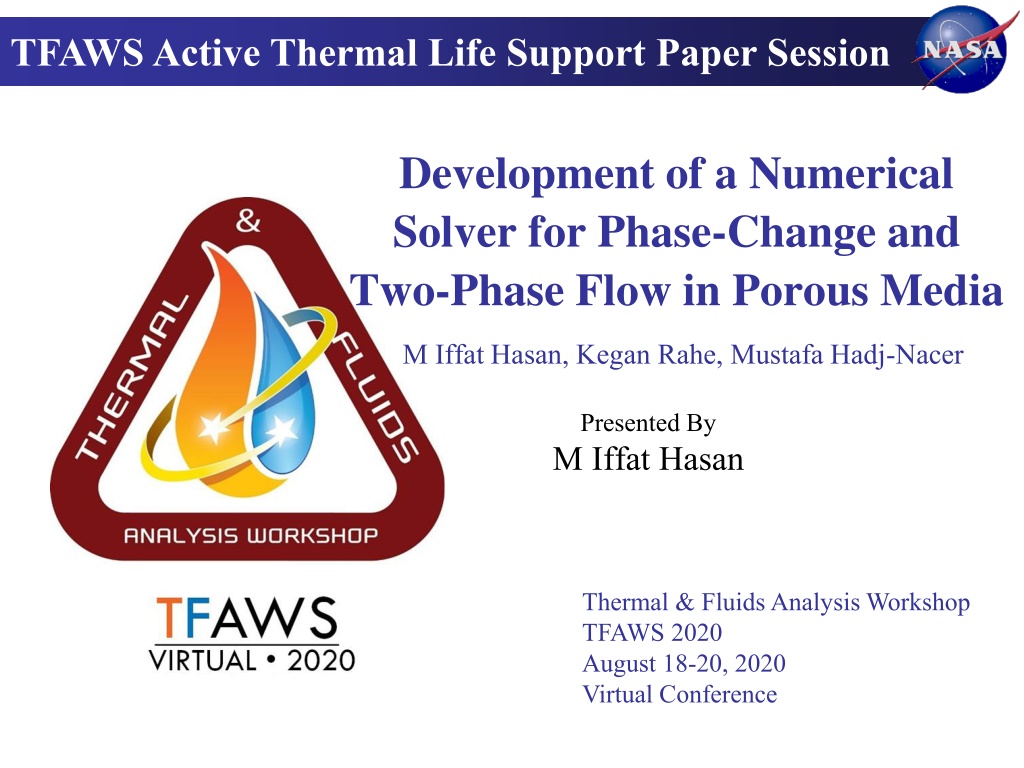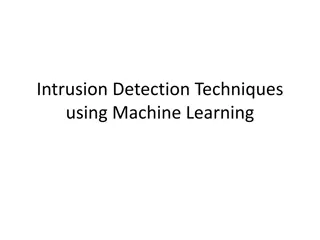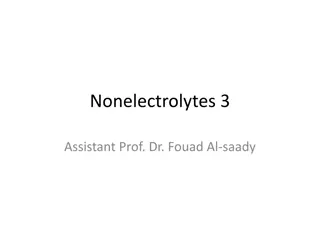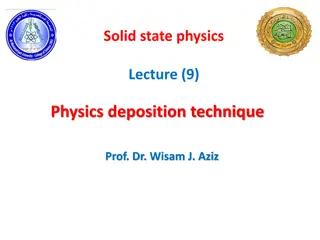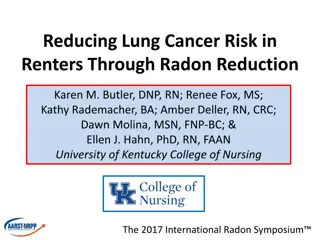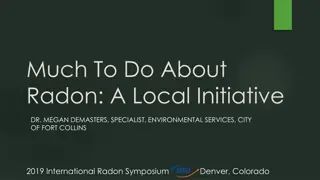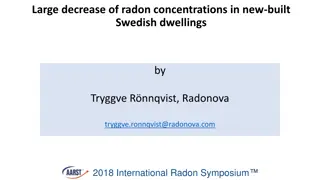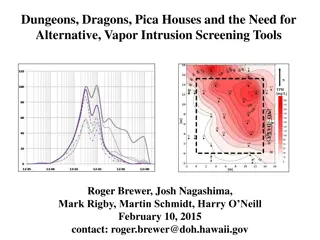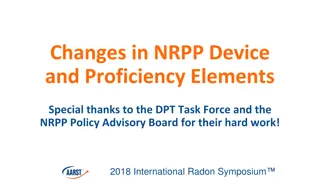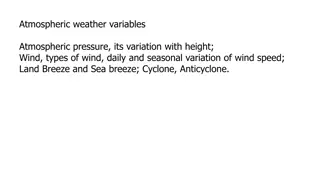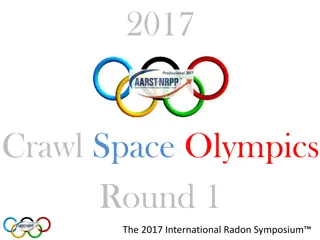TM2024 Radon and Vapor Intrusion Symposium
This symposium focuses on addressing radon and vapor intrusion in indoor environments. Experts discuss strategies, technologies, and solutions to mitigate risks associated with these environmental factors. The event aims to raise awareness and promote best practices for maintaining healthy indoor air quality.
Download Presentation

Please find below an Image/Link to download the presentation.
The content on the website is provided AS IS for your information and personal use only. It may not be sold, licensed, or shared on other websites without obtaining consent from the author.If you encounter any issues during the download, it is possible that the publisher has removed the file from their server.
You are allowed to download the files provided on this website for personal or commercial use, subject to the condition that they are used lawfully. All files are the property of their respective owners.
The content on the website is provided AS IS for your information and personal use only. It may not be sold, licensed, or shared on other websites without obtaining consent from the author.
E N D
Presentation Transcript
TFAWS Active Thermal Life Support Paper Session Development of a Numerical Solver for Phase-Change and Two-Phase Flow in Porous Media M Iffat Hasan, Kegan Rahe, Mustafa Hadj-Nacer Presented By M Iffat Hasan Thermal & Fluids Analysis Workshop TFAWS 2020 August 18-20, 2020 Virtual Conference
INTRODUCTION TFAWS 2020 August 18-20, 2020 2
Background Advanced thermal management system Surface Water Ocean Topography (SWOT) Single-Phase Systems Typically employed by NASA Poor isothermality, unless high-pumping power is used Two-Phase Systems Liquid is evaporated and vapor is transported to a condenser where is used or rejected to space Passive phase-change thermal management systems (does not require a pump) Can achieve high isothermality and are thermally stable 3 TFAWS 2020 August 18-20, 2020 3
Loop Heat Pipe (LHP) Liquid is evaporated at the evaporator Capillary effect drives the flow in the system Vapor is condensed and heat is rejected Liquid return to the evaporator Accumulator regulate loop temperature 4 TFAWS 2020 August 18-20, 2020 4
Pumped Loop Heat Pipe A pump is added in the liquid line Assist the porous wick Enhance performance of the loop Accommodate higher heat fluxes 5 TFAWS 2020 August 18-20, 2020 5
Objectives The overall objective of our research is to develop technologies that can be used to design two-phase loop heat pipes in microgravity for space applications. The main focus of this thesis is to develop a solver in the OpenFOAM architecture that can model all the relevant physics of flow and phase-change in porous media. 6 TFAWS 2020 August 18-20, 2020 6
SOLVER DEVELOPMENT 7 TFAWS 2020 August 18-20, 2020 7
Approach Employ an existing porous multiphase solver in OpenFoam, impesFoam, and customizing it by including: The energy equation Phase-change models Capillarity and relative permeability models Effective thermal conductivity models Temperature-dependent density, viscosity and thermal conductivity. 8 TFAWS 2020 August 18-20, 2020 8
Governing Equations Pressure Equation ?? ??? ?? ??=? ?? . ????(??) ?? ??? + . ????(??) 1 ?? 1 ?? ?? ?? ?? Saturation Equation ? ?? ?? ?? ???? ??+ ?.??= Energy Equation ? ????+1 ? ???? ?? ??+ ???? . ?? = . ???? ? ? ?? 9 TFAWS 2020 August 18-20, 2020 9
Phase-Change Models Empirical Rate Parameter ? ???? ???? ? ???? ? ??= ?????? ?? , ? ???? ? ??= ??(1 ??)?? ?? , ? < ???? ???? Interface Equilibrium ? ???? ? ? ??= ????? 10 TFAWS 2020 August 18-20, 2020 10
Capillarity Models Van Gunechten Model 1 ?, 1 1 ? 1) ?? ??,??= ??,0(??,?? ?= 1 ? ?? ???,??? ???,??? ???,??? ??,??= Leverett s Model ??= ?? ??= ?? ?? ? ? ? ??= 1.4171 ?? 2.121 ??2+ 1.2631 ??3 11 TFAWS 2020 August 18-20, 2020 11
Relative Permeability Models Van Gunechten Model 1 ? 1 2(1 ??,??? )2? ??? ??,???= ???,???1 ??,??? 1 ? 1 2(1 (1 ??,??? )?)2 ??? ??,???= ???,??? ??,??? ?? ??,??? 1 ??,??? ??,??? ??,???= Carman-Kozeny Model 3 ??? = ?? ??? = (1 ??)3 12 TFAWS 2020 August 18-20, 2020 12
Effective Thermal Conductivity Models Parallel Model ????= ???+ (1 ?)?? Series Model 1 ? +1 ? = ???? ?? ?? Alexander Model (1 ?)? ????= ?? ?? ?? Chi Model 2 2 ???? ????=? 8 ?? ??+1 ? 8 ?? ?? ?? ? ??+ (1 ? )?? ? ? = 2 1 ? 8 ?? ?? 13 TFAWS 2020 August 18-20, 2020 13
Solver Work Flow 14 TFAWS 2020 August 18-20, 2020 14
RESULTS 15 TFAWS 2020 August 18-20, 2020 15
Numerical Study (1-D) Simulation Domain, and Initial and Boundary Conditions x Inlet Outlet ???= 300 K ?? = 3 10 ??= 1 ????= 1580 K ????= 0 Pa g 4?/? Permeability, K = 2 10-12 m2 Porosity, = 38% L = 10 cm 16 TFAWS 2020 August 18-20, 2020 16
Result and Discussion (1-D) x Liquid Vapor 2? Saturation Contour and Axial profile of saturation of the domain Three different zones are observed. Liquid zone (6.5cm), two- phase zone (1.5cm) and vapor zone (2cm). 17 TFAWS 2020 August 18-20, 2020 17
Result and Discussion (1-D) (a) (b) Axial (a) liquid velocity and (b) vapor velocity profiles in the domain Inlet liquid velocity drops to 7. 25 10-5 m/s and remain constant in the Liquid zone. Due to the capillarity at two-phase zone liquid velocity increases. In two-phase zone vapor velocity is negative to keep the mass conservation. In vapor zone full liquid momentum transferred to vapor, vapor velocity increases to positive value 18 TFAWS 2020 August 18-20, 2020 18
Result and Discussion (1-D) (a) (b) Axial (a) pressure and (b) temperature profiled in the domain Nearly constant value of pressure is observed in the Liquid zone. It is predicted that this irregularity is because of the initial drop in velocity. Temperature increase gradually in the liquid and rapidly in the vapor zone because of the effective thermal conductivity. 19 TFAWS 2020 August 18-20, 2020 19
Comparison with a Semi-Analytical Model Current Model He et. al. [1] Length of vapor zone (cm) 2 2.1 Length of two-phase zone (cm) 1.5 0.8 There are some dissimilarities between the two models. However, the shape of the plots is similar. Our model qualitatively produces similar two-phase zone behavior. But, due to some issues, we are not yet able to get accurate quantitative results. 1. Fei He, Jianhua Wang, Lucheng Xu, Xiaochun Wang, Modeling and simulation of transpiration cooling with phase change, Applied Thermal Engineering, Volume 58, Issues 1 2, 2013, Pages 173-180. 20 TFAWS 2020 August 18-20, 2020 200
Numerical Study (2-D) Simulation Domain, and Initial and Boundary Conditions Permeability, K = 10-11 m2 Porosity, = 50% No Gravity y x 21 TFAWS 2020 August 18-20, 2020 211
Saturation Contour of Liquid Liquid saturation around the heated plate is 0.74 Liquid is accumulating at the outlet while vapor is leaving the domain. y x 22 TFAWS 2020 August 18-20, 2020 222
Results and Discussion y x Temperature contour of the domain Higher temperature is observed around heated plate. 23 TFAWS 2020 August 18-20, 2020 233
Results and Discussion (a) (b) Axial (a) Liquid velocity profile at inlet and (b) Vapor velocity profile at outlet Larger liquid velocity is observed in the region above the heated plate. Vapor velocity is increasing near heated plate. 24 TFAWS 2020 August 18-20, 2020 244
CONCLUSIONS AND FUTURE WORKS 25 TFAWS 2020 August 18-20, 2020 255
Conclusions A numerical solver, phaseChangeImpesFoam for two-phase flow and phase-change in porous media is developed Phase-change, capillarity, relative permeability, and effective thermal conductivity models and temperature-dependent fluid properties were introduced in the solver. Two simple example cases are presented to demonstrate the capabilities of the new solver. The first case is a 1-D simulation performed with constant fluid properties. o Results were compared with a semi-analytical model developed by He et al. [1]. o Our solver was able to qualitatively predict the correct behavior for the flow and phase-change but cannot predict the correct pressure profile in the liquid zone, and temperature profile in the two-phase region. The second simulated case was a 2-D domain representing a segment of the porous wick of an LHP evaporator. o Results showed that liquid does not fully convert into vapor when the heated plate temperature is slightly above the saturation temperature. o Higher vapor velocity and temperature are observed near the heated plate. 26 TFAWS 2020 August 18-20, 2020 266
Future Works The solver is still not yet complete and it is still in the development process. For the future, we will: Continue improving the solver by fixing the issues and implementing other phase-change models Validate the solver with experimental data obtained from a quasi 2-D experiment being constructed by our group. Couple the solver with a flow and phase-change solver in open-spaces (not porous media). This will create a robust solver that can be used for multiple applications. o o o 27 TFAWS 2020 August 18-20, 2020 277
ACKNOWLEDGMENT This work was supported by the NASA EPSCoR program under Cooperative Agreement Number: NNX15AM77A 28 TFAWS 2020 August 18-20, 2020 288
Thank You! Questions? TFAWS 2020 August 18-20, 2020 299
